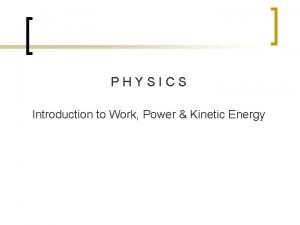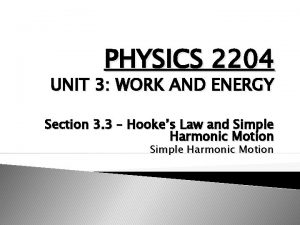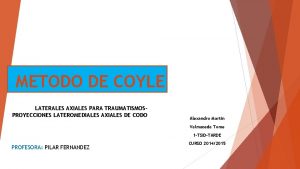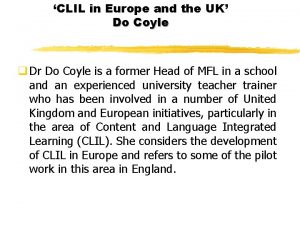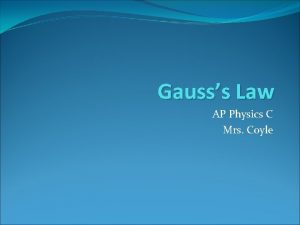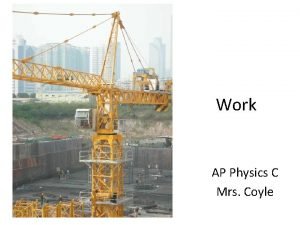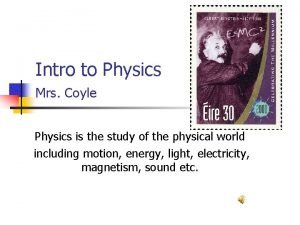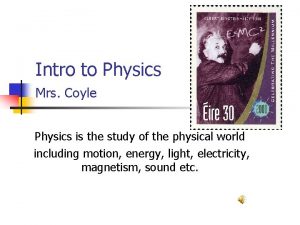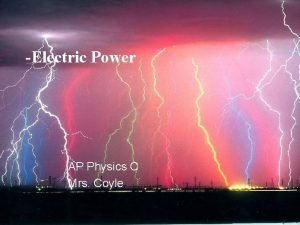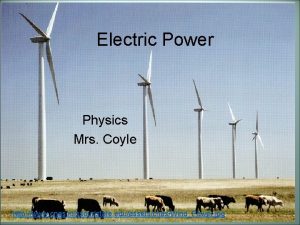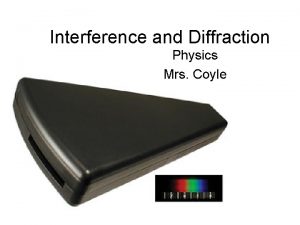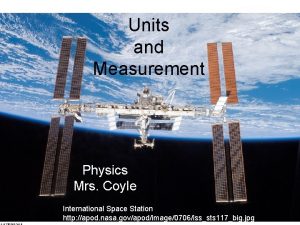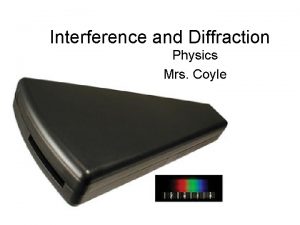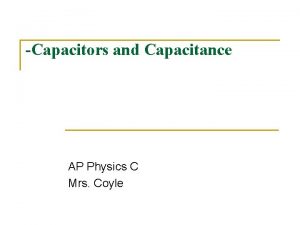Work and Power Physics Mrs Coyle What is




















- Slides: 20

Work and Power Physics Mrs. Coyle

What is the direction of the component of the force that causes the sled to move?

What component of F applied causes this object to move?

Work • The work done on an object by an external constant force: W= F d cos q • is the angle between the displacement d and the force F.

Work • Is a scalar quantity. • Unit: • Joule= Newton ∙ meter J= N∙m • James Prescott Joule English, 19 th. Century

• When the force is in the direction of the displacement, =0 o: cos 0= 1 => W= F d and work is positive Which force acting on the sled does positive work?

When the force acts opposite to the direction of the displacement, =180 o: cos 180 o = -1 => W= F d and work is negative Which force acting on the sled does negative work?

When the force acts perpendicular to the displacement, then the work done by that force is zero. What force(s) acting on the sled does no work?

Question • Does the centripetal force do work?

Meaning of Sign of Work When the work done by an external force onto the system is: + : the system gains energy - : the system loses energy

Example 1 • How much work was done by the 30 N applied tension force to move the 6 kg box along the floor by 20 m? (A: 300 J) • How much work did the weight do in the same case? • If µ=0. 2, how much work did the friction do? (Hint: Use Fxnet to calculate N) (A: -136 J)

Work done by Resultant W= W 1+ W 2+ Wn Since work is a scalar, the net work done by a resultant force is equal to the sum of the individual works done by each individual force acting on the object.

Example 2 • How much total work is done on a sled that moves at constant velocity?

Work is the area under an F vs d graph.

Power, P= W = Fdcos q t t • Rate • Scalar • Unit : J/s = W ( Watt) • James Watt (18 th Century) developed the steam engine.

Power P= W = Fdcos q = Fvcos q t t

kilo. Watt∙ hour Does a k. Watthour (k. Wh) measure: Power or Work

Pile Driver

Example 3 A pile driver drives a pile in 10 m with a force of 2000 N in 0. 05 s. 1. Calculate the work done by the driver. (A: 2 x 104 J) 2. Calculate the power of the driver. (A: 4 x 105 W)

Example 4 • An engine moves a boat through the water at a speed of 12 m/s. The force exerted by the engine is 5500 N. What is the power of the engine? • Answer: 6. 6 x 104 W
 They are mrs garcia and mrs castro
They are mrs garcia and mrs castro They are mrs garcia and mrs castro
They are mrs garcia and mrs castro Physics 03-02 potential energy and conservative forces
Physics 03-02 potential energy and conservative forces Mrs. darling was ___________ of mrs. s.
Mrs. darling was ___________ of mrs. s. 0kei0
0kei0 Power vs work
Power vs work Work and energy
Work and energy Physics 2204 unit 3: work, power, energy
Physics 2204 unit 3: work, power, energy Coyle and castello method
Coyle and castello method Coyle health and wellbeing
Coyle health and wellbeing Real power and reactive power
Real power and reactive power L coyle
L coyle Coyle method
Coyle method Caitlin coyle
Caitlin coyle Do coyle
Do coyle Coyle bernard
Coyle bernard Coyle
Coyle Gauss law ap physics c
Gauss law ap physics c Aaron coyle
Aaron coyle University of nottingham
University of nottingham Dr christine coyle
Dr christine coyle





